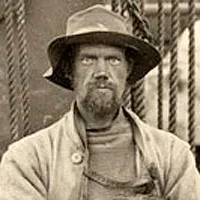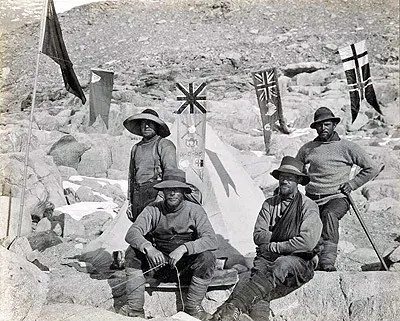Thomas Griffith Taylor - Geologist
1880 - 1963 - Biographical
notes
Geologist Terra Nova 1910-13

Thomas Griffith Taylor
1st December 1880 - 5th November 1963
Born in Walthamstow, England, the family emigrated to Australia when Thomas was 13, he attended the University of Sydney, initially in the arts but graduating in mining and metallurgy in 1905. He was awarded a scholarship to Cambridge University in 1907 when he became friends with Raymond Priestley, Charles Wright and Frank Debenham all of whom he recruited to Scott's Terra Nova expedition.
Taylor was the leader of the geological team who made the first geological maps and studies of large areas of Antarctica, leading two journeys to never explored areas to do so. The first of these was a summer and autumn trip which started in Jan 1911 and lasted for 11 weeks, much of it in "Dry Valley", now renamed Taylor Valley after it was found to be one of several dry valleys rather than being the only one.
The second trip took place the following spring, leaving the base hut in Nov 1911 with a scheduled pick-up by the Terra Nova on Jan 15th 1912, though the ship could not reach them because of sea-ice, on the 5th of Feb, they set off across the ice where they were seen and picked up by the ship on the 18th of Feb, returning home in March unaware of the fate of Scott and his party.
Taylor's work in Antarctica earned him a doctorate from the University of Sydney and he was made a fellow of the Royal Geographical Society of London and an Associate Professor of Geography at Sydney in 1921 where he was the founding head of the Geography Department. He became a controversial character partly due to his views on race and opposition of the Government's White Australia policy, and partly due to what were seen at the time as his pessimistic views on Australia's arid interior leading for a time to a ban on some of his works, he also wrote widely on human races. While he faced strong opposition at the time from some powerful people who opposed his views, he is now highly regarded for his remarkably accurate predictions.
References to Thomas Griffith Taylor by Cherry-Garrard in "The Worst Journey in the World"
-
Taylor especially is seldom at a loss for conversation and his remarks are generally original, if sometimes crude. Most of us were glad to listen when the discussions in which he was a leading figure raged round the blubber stove.
-
During the geological journey on the western side of the Sound, Taylor and his party had carried out much useful geological work in Dry Valley and on the Ferrar and Koettlitz Glaciers, which had been accurately plotted for the charts, and had been examined for the first time by an expert physiographer and ice specialist.
-
During his absence Griffith Taylor became meteorologist-in-chief. He was a greedy scientist, and he also wielded a fluent pen. Consequently his output during the year and a half which he spent with us was large, and ranged from the results of the two excellent scientific journeys which he led in the Western Mountains, to this work during the latter half of September. He was a most valued contributor to The South Polar Times, and his prose and poetry both had a bite which was never equalled by any other of our amateur journalists. When his pen was still, his tongue wagged, and the arguments he led were legion. The hut was a merrier place for his presence. When the weather was good he might be seen striding over the rocks with a complete disregard of the effect on his clothes: he wore through a pair of boots quicker than anybody I have ever known, and his socks had to be mended with string. Ice movement and erosion were also of interest to him, and almost every day he spent some time in studying the slopes and huge ice-cliffs of the Barne Glacier, and other points of interest. With equal ferocity he would throw himself into his curtained bunk because he was bored, or emerge from it to take part in some argument which was troubling the table. His diary must have been almost as long as the reports he wrote for Scott of his geological explorations. He was a demon note-taker, and he had a passion for being equipped so that he could cope with any observation which might turn up. Thus Old Griff on a sledge journey might have notebooks protruding from every pocket, and hung about his person, a sundial, a prismatic compass, a sheath knife, a pair of binoculars, a geological hammer, chronometer, pedometer, camera, aneroid and other items of surveying gear, as well as his goggles and mitts. And in his hand might be an ice-axe which he used as he went along to the possible advancement of science, but the certain disorganization of his companions.
His gaunt, untamed appearance was atoned for by a halo of good-fellowship which hovered about his head. I am sure he must have been an untidy person to have in your tent: I feel equally sure that his tent-mates would have been sorry to lose him. His gear took up more room than was strictly his share, and his mind also filled up a considerable amount of space. He always bulked large, and when he returned to the Australian Government, which had lent him for the first two sledging seasons, he left a noticeable gap in our company.
References to Thomas Griffith Taylor by Scott in "Scott's Last Expedition"
-
As I came down the hill yesterday I saw a strange figure advancing and found it belonged to Griffith Taylor. He and his party had returned safely. They were very full of their adventures. The main part of their work seems to be rediscovery of many facts which were noted but perhaps passed over too lightly in the Discovery - but it is certain that the lessons taught by the physiographical and ice features will now be thoroughly explained.
-
Taylor gave a most interesting lecture on the physiographic features of the region traversed by his party in the autumn. His mind is very luminous and clear and he treated the subject with a breadth of view which was delightful.
-
Troubles rarely come singly, and it occurred to me after Clissold had been brought in that Taylor, who had been bicycling to the Turk's Head, was overdue. We were relieved to hear that with glasses two figures could be seen approaching in South Bay, but at supper Wright appeared very hot and said that Taylor was exhausted in South Bay--he wanted brandy and hot drink. I thought it best to despatch another relief party, but before they were well round the point Taylor was seen coming over the land. He was fearfully done. He must have pressed on towards his objective long after his reason should have warned him that it was time to turn; with this and a good deal of anxiety about Clissold, the day terminates very unpleasantly.
Landmarks named after Thomas Griffith Taylor
Feature Name:
Taylor Glacier, Taylor Valley,
and Taylor Dome
Type: glacier,
valley and summit
Latitude: 77°45'S
Longitude: 161°45'E
Description:
Glacier -
1.5 mi wide, lying E of Hayes Peak and flowing N into the sea
just E of Cape Bruce. Discovered in February 1931 by the British
Australian and New Zealand Antarctic Research Expedition (BANZARE)
under Mawson.
Valley - An ice-free valley about 18 mi long, once occupied by the receding Taylor Glacier, lying N of the Kukri Hills between the Taylor Glacier and New Harbor in Victoria Land. Discovered by the British National Antarctic Expedition (BrNAE) (1901-04), it was more fully explored by the British Antarctic Expedition (BrAE) (1907-09) and the British Antarctic Expedition (BrAE) (1910-13). Named after the Taylor Glacier.
Dome - An elliptical ice dome, 43 mi long ESE-WNW and 16 mi wide, rising to 2,400 m, centered c. 29 mi WNW of Mount Crean, Lashly Mountains, Victoria Land. The feature was delineated by the SPRI-NSF-TUD airborne radio echo sounding program, 1967-79. The name was first used by David J. Drewry of SPRI in 1980. The dome is one of the local sources of ice to the Taylor Glacier, from which it is named.
Feature Name:
Taylor Glacier
Type: glacier
Latitude:
77°44'S
Longitude: 162°10'E
Description: Glacier about 35 mi long,
flowing from the plateau of Victoria Land into the W end of
Taylor Valley, N of the Kukri Hills. Discovered by the British
National Antarctic Expedition (BrNAE) (1901-04) and at that
time thought to be a part of Ferrar Glacier. The Western Journey
Party of the British Antarctic Expedition (BrAE) (1910-13) determined
that the upper and lower portions of what was then known as
Ferrar Glacier are apposed, i.e., joined in Siamese-twin fashion
N of Knobhead. With this discovery Scott named the upper portion
for Griffith Taylor, geologist and leader of the Western Journey
Party.
Other Crew of the Terra Nova Expedition
Abbot,
George Percy - Petty Officer, R.N. - 1, 2, N
Atkinson, Edward
L. - R.N. - surgeon, parasitologist - 1, 2, D, P, S
Balson,
Albert - Leading seaman, R.N.- 1, 2
Bowers,
Henry Robertson - Lieutenant - 1, 2, D, C,
Po
Browning,
Frank Vernon - Petty Officer - 1, 2, N
Campbell,
Victor - Lieutenant, R.N. - 1, 2, N
Cheetham,
Alfred B. - Boatswain (Bosun), R.N.R.
Cherry-Garrard,
Apsley - Assistant zoologist - 1, 2, D, C, S
Crean,
Tom - petty officer, R.N. - 1, 2, D, P, S
Debenham, Frank
- Geologist - 1, 2, iW, iiW
Dickason,
Harry - Able Seaman - 1, 2, N
Evans, Edgar - petty
officer, R.N. - 1, iW, Po
Evans, Edward R.G.R. - Lieutenant, R.N. "Teddy Evans" -
second in command, and Captain of the Terra Nova - 1, D, P
Girev
(Geroff), Dmitriy - Dog driver - 1, 2, D, P, S
Gran,
Tryggve - ski expert - 1, 2, D, iiW, S
Lashly, William
- chief stoker, R.N. - 1, 2, P, S
Levick,
G. Murray - Surgeon, R.N. - 1, 2, N
Lillie, Dennis Gascoigne - Biologist
on the ship
McLeod, Thomas
F. - Able seaman - 1, 2
Meares, Cecil
H. - in charge of dogs - 1, D, P
Oates, Lawrence
- Capt. 6th Iniskilling Dragoons - 1, D,
Po
Ponting,
Herbert G. - Camera artist - 1
Priestley,
Raymond E. - Geologist - 1, 2, N
Omelchenko,
Anton - Groom - 1
Scott, Robert
Falcon - Commander, R.N. -
Expedition leader - 1, D, Po
Simpson,
George - Meteorologist - 1
Taylor,
T. Griffith - Geologist - 1, iW, iiW
Wilson,
Edward Adrian - chief of scientific staff and biologist - 1, D, C,
Po
Wright,
Charles Seymour - Physicist - 1, 2, iW, P, S
Key:
1 - first winter
2 - second winter
iW - first western party
iiW - second western party
N - northern
party
D - depot laying for south pole journey
P - south pole party
C - winter journey to Cape Crozier
S - search party for south Pole
party
Po - reached
South Pole
Biographical information
- I am concentrating on the Polar experiences of the men involved.
Any further information or pictures visitors may have will be gratefully received.
Please email
- Paul Ward, webmaster.
What are the chances that my ancestor was an unsung part of the Heroic Age
of Antarctic Exploration?



